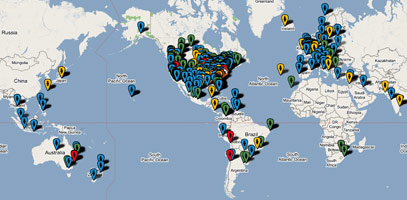 If you're as lazy as the rest of us, then getting up to change what's playing on iTunes or to adjust the volume is just too much like work especially if you've installed one of our PBX-in-a-Flash™ Asterisk® systems on either a dedicated Linux machine or your Windows Desktop. For long-time readers of Nerd Vittles, you may recall that we covered how to build a streaming audio server using iTunes last year. So today we add the missing piece which will let you change songs, adjust the volume, and pause and restart iTunes using any touchtone phone connected to your Asterisk or TrixBox system. Special thanks to jpe for figuring all of this out and to Acme Technologies and to David Schlosnagle for their work on the iTunes Command Line Interface.
If you're as lazy as the rest of us, then getting up to change what's playing on iTunes or to adjust the volume is just too much like work especially if you've installed one of our PBX-in-a-Flash™ Asterisk® systems on either a dedicated Linux machine or your Windows Desktop. For long-time readers of Nerd Vittles, you may recall that we covered how to build a streaming audio server using iTunes last year. So today we add the missing piece which will let you change songs, adjust the volume, and pause and restart iTunes using any touchtone phone connected to your Asterisk or TrixBox system. Special thanks to jpe for figuring all of this out and to Acme Technologies and to David Schlosnagle for their work on the iTunes Command Line Interface.
Overview. To get things working, there are just a few, easy steps. First, you'll need a Mac running the Panther or Tiger versions of Mac OS X. Next, you'll need to download and install the iTunes Command Line Interface. Then you'll need a rock-solid Asterisk system. We recommend TrixBox 1.2.3 which you can install using our tutorial and installation scripts above. Finally, we'll add a voice prompt and tweak the dialplan a bit using freePBX to handle the telephony interface to iTunes. And, presto, you're done.
Installing the iTunes CLI. We're assuming you've already got a Mac up and running with the required version of Mac OS X. If not, start there. Then download the iTunes Command Line Interface onto your Mac Desktop. Unless you've secured Safari, it will decompress the downloaded file automatically leaving you an iTunes Remote Control folder on your Desktop. If it doesn't automatically decompress the .sit file, then just double-click on it. Now open a Terminal window and switch to root access using your Mac password: sudo su. Then execute the following commands:
cd Desktop
cd "iTunes Remote Control"
cp itunes /bin/itunes
chmod +x /bin/itunes
ifconfig
itunes play
itunes play
The ifconfig command lets you decipher the private IP address of your Mac. Write down the inet address for the network interface you're using to connect your Mac to your private network (usually found in the listing for en0 or en1). To complete the installation on the Asterisk box, you'll also need to know a username and password for your Mac. If you don't know, you can find all your Mac usernames by changing to the /Users folder and typing ls. The last two commands should crank up iTunes on your Mac Desktop and begin playing whatever the last song or podcast you listened to. If everything's working, you can close the Terminal window on your Mac. We're done with the Mac part of the drill.
Password-Free SSH Access. As with our Proximity Detection System and Backup tutorials, we want to use SSH to communicate between the Asterisk system and iTunes on your Mac. As you know, SSH typically prompts for a password when you connect to a remote resource. So here's the trick if you haven't read our previous articles. Log into your Asterisk system as root. Because the Asterisk system will actually be the actual user connecting with SSH, we need to switch from the root user to the asterisk user account to get things set up correctly: su asterisk. Then, from the command prompt, issue the following command: ssh-keygen -t rsa. Press the enter key three times. You should see something similar to the following. The file name and location in bold below is the information we need:
Generating public/private rsa key pair.
Enter file in which to save the key (/var/lib/asterisk/.ssh/id_rsa):
Enter passphrase (empty for no passphrase):
Enter same passphrase again:
Your identification has been saved in /var/lib/asterisk/.ssh/id_rsa.
Your public key has been saved in /var/lib/asterisk/.ssh/id_rsa.pub.
The key fingerprint is:
1d:3c:14:23:d8:7b:57:d2:cd:18:70:80:0f:9b:b5:92 asterisk@asterisk1.local
Now we want to copy the public key file (in bold above) to your Mac from your Asterisk system using SCP. The command should look like the following (except use the private IP address of your Mac instead of 192.168.0.104 and use your Mac username instead of the two instances of username below). Provide the Mac password for the username you've chosen when prompted to do so.
scp /var/lib/asterisk/.ssh/id_rsa.pub username@192.168.0.104:/Users/username/.ssh/authorized_keys
Once the file has been copied, you now should be able to log into your Mac from your Asterisk system using SSH without being prompted for a password. Let's try it. Here's the command. Just substitute your username and the IP address of your Mac below:
ssh username@192.168.0.104
You should be admitted without entering a password. Type exit twice to log out of your Asterisk system and to log out as user asterisk. If it didn't work, repeat the drill or read the complete article and find where you made a mistake.
Modifying Your Dialplan to Support the iTunes CLI. Now we're ready to cut and paste some code. Connect to your Asterisk system using your web browser by pointing to the internal IP address of your server: http://192.168.0.104. Choose System Administration and log in with username maint and your password. Now choose Config Edit and click on extensions-trixbox.conf in the list of config files. When the editor opens, add the following lines in the [from-internal-trixbox] context of the file:
exten => 673,1,Answer ; Dial MP3 to manage iTunes
exten => 673,2,Wait(1)
exten => 673,3,DigitTimeout(5)
exten => 673,4,ResponseTimeout(7)
exten => 673,5,Goto(itunes,s,1)
This will let you dial MP3 or 6-7-3 from any extension on your Asterisk system to manage iTunes on your Mac. While you're still editing extensions-trixbox.conf, scroll to the bottom of the file and add the following chunk of code:
[itunes]
exten => s,1,setvar(user=username)
exten => s,2,setvar(ituneshost=192.168.0.104)
exten => s,3,background(custom/itunes)
exten => s,4,background(beep)
exten => 1,1,system(ssh ${user}@${ituneshost} /bin/itunes mute)
exten => 1,2,goto(99,1)
exten => 2,1,system(ssh ${user}@${ituneshost} /bin/itunes pause)
exten => 2,2,goto(99,1)
exten => 3,1,system(ssh ${user}@${ituneshost} /bin/itunes unmute)
exten => 3,2,goto(99,1)
exten => 4,1,system(ssh ${user}@${ituneshost} /bin/itunes prev)
exten => 4,2,goto(99,1)
exten => 5,1,system(ssh ${user}@${ituneshost} /bin/itunes play)
exten => 5,2,goto(99,1)
exten => 6,1,system(ssh ${user}@${ituneshost} /bin/itunes next)
exten => 6,2,goto(99,1)
exten => 7,1,system(ssh ${user}@${ituneshost} /bin/itunes vol 25)
exten => 7,2,goto(99,1)
exten => 8,1,system(ssh ${user}@${ituneshost} /bin/itunes vol 50)
exten => 8,2,goto(99,1)
exten => 9,1,system(ssh ${user}@${ituneshost} /bin/itunes vol 100)
exten => 9,2,goto(99,1)
exten => 0,1,system(ssh ${user}@${ituneshost} /bin/itunes mute)
exten => 0,2,goto(99,1)
exten => *,1,system(ssh ${user}@${ituneshost} /bin/itunes vol down)
exten => *,2,goto(99,1)
exten => #,1,system(ssh ${user}@${ituneshost} /bin/itunes vol up)
exten => #,2,goto(99,1)
exten => 99,1,NoOp(${SYSTEMSTATUS})
exten => 99,2,GotoIf($["${SYSTEMSTATUS}" = "APPERROR"]?99,6)
exten => 99,3,background(num-was-successfully)
exten => 99,4,background(activated)
exten => 99,5,goto(s,4)
exten => 99,6,background(im-sorry)
exten => 99,7,background(an-error-has-occured)
exten => 99,8,wait(1)
exten => 99,9,background(goodbye)
exten => 99,10,Hangup
exten => t,1,goto(s,1)
exten => h,1,Hangup
Now move up to the first line of code (s,1) and change username to reflect the account name on your Mac that will be used to manage iTunes. It's got to be the same one that was used in the SSH keygen step above! Now move to the second line of code (s,2) and plug in the IP address of the Mac running iTunes. Save your changes by clicking the Update button. Close your browser, and don't worry about restarting Asterisk just yet because we have one final step to go.
 Installing the iTunes CLI Voice Prompt. Just to give our new system a professional touch, let's add a custom voice prompt from Allison Smith to greet callers dialing MP3 on your system. Log into your Asterisk server as root and issue the following commands. The final one will restart Asterisk to load our dialplan updates from above.
Installing the iTunes CLI Voice Prompt. Just to give our new system a professional touch, let's add a custom voice prompt from Allison Smith to greet callers dialing MP3 on your system. Log into your Asterisk server as root and issue the following commands. The final one will restart Asterisk to load our dialplan updates from above.
cd /var/lib/asterisk/sounds/custom
wget http://nerdvittles.com/trixbox123/itunes.gsm
chown asterisk:asterisk itunes.gsm
amportal restart
Taking the iTunes Controller for a Spin. Now that the installation is complete, let's try it out. Make sure your Mac is turned on. Then pick up a telephone on your system and dial MP3. You'll be welcomed by Allison and prompted to enter a command. Using the commands shown on the adjacent keypad diagram, you can control virtually all aspects of iTunes. When you've finished entering commands, just hang up. It's that simple. If you happen to be streaming iTunes music to other desktops or your cellphone, then you'll really appreciate this addition to your Asterisk application software collection. Enjoy!

 Nerd Vittles Demo Hot Line. You now can take a number of Nerd Vittles projects for a test drive... by phone! The current demos include NewsClips for Asterisk (latest news headlines in dozens of categories), MailCall for Asterisk with password 1111 (retrieve your email by phone), and Nerd Vittles Weather Forecasts by U.S. Airport Code. Just call our number (shown in the left margin) and take any or all of them for a spin. The sound quality may not be perfect due to performance limitations of our ancient Intel 386 demo machine. But the price is right.
Nerd Vittles Demo Hot Line. You now can take a number of Nerd Vittles projects for a test drive... by phone! The current demos include NewsClips for Asterisk (latest news headlines in dozens of categories), MailCall for Asterisk with password 1111 (retrieve your email by phone), and Nerd Vittles Weather Forecasts by U.S. Airport Code. Just call our number (shown in the left margin) and take any or all of them for a spin. The sound quality may not be perfect due to performance limitations of our ancient Intel 386 demo machine. But the price is right.
Nerd Vittles Fan Club Map. Thanks for visiting! We hope you'll take a second and add yourself to our Frappr World Map compliments of Google. In making your entry, you can choose an icon: guy, gal, nerd, or geek. For those that don't know the difference in the last two, here's the best definition we've found: "a nerd is very similar to a geek, but with more RAM and a faster modem." We're always looking for the best BBQ joints on the planet. So, if you know of one, add it to the map while you're visiting as well.
Hosting Provider Special. Just an FYI that the Nerd Vittles hosting provider, BlueHost, has raised the bar again on hosting services. For $6.95 a month, you can host up to 6 domains with 50GB of disk storage and 999GB of monthly bandwidth. Free domain registration is included for as long as you have an account. That almost doubles last month's deal, and it really doesn't get any better than that. Their hosting services are flawless! We oughta know. We've tried the best of them. If you haven't tried a web hosting provider, there's never been a better time. Just use our link. You get a terrific hosting service, and we get a little lunch money.
Want More Projects? For a complete catalog of all our previous Asterisk projects, click here. For the most recent articles, click here and just scroll down the page.
Headline News for the Busy Executive and the Lazy Loafer. Get your Headline News the easy way: Planet Asterisk, Planet Gadget, Planet Mac, and Planet Daily. Quick read, no fluff.
Got a PDA or Web-Enabled Smartphone? Check out our new PDAweather.org site and get the latest weather updates and forecasts from the National Weather Service perfectly formatted for quick download and display on your favorite web-enabled PDA, cellphone, or Internet Tablet. And, of course, it's all FREE!



 JUST RELEASED: Visit the Incredible PBX Wiki
JUST RELEASED: Visit the Incredible PBX Wiki
Ward;
Great tutorial as usual. Please show us how to use it on our MOH.
[WM: Read the article about streaming audio that is referenced above. And then read this one.]
THANKS UNCLE WARD!!!
With out nerdvittles I would have not been inspired nor had a good reference.
jpe a/k/a J.P. Edmund
Great article. Hope you’ll do more Mac stuff in the future. We miss your old Mac stuff!!